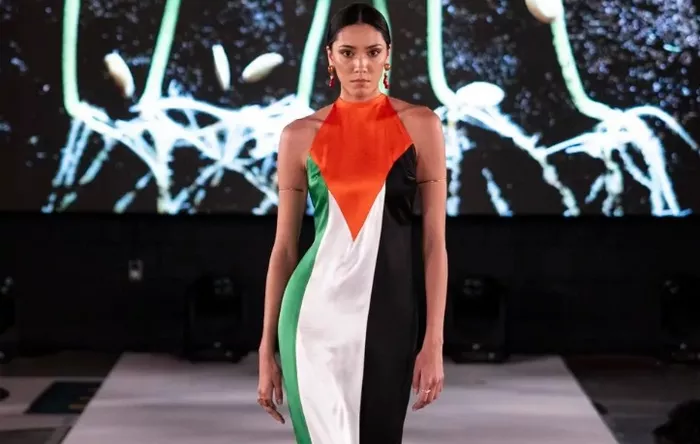At Santa Fe’s Native American Fashion Week, the message is clear: Indigenous fashion is not just about style—it’s about asserting presence, telling stories, and pushing back against erasure. Amber Dawn, founder of Native Fashion Week, powerfully states, “Native people are still here. We always have been. But too often, this country acts like we’re not.” Her vision challenges the historical marginalization of Indigenous culture in fashion, museums, media, and beyond.
The week-long event opened in the Santa Fe Railyard—a site historically tied to colonization and expansion. Symbolically, Native Fashion Week’s launch there served as a reclamation of that very history. During the event’s kickoff titled “Runway on the Rails,” designers Nonamey and Ayimach Horizons previewed collections aboard the Sky Railway during a scenic two-hour ride into the desert. From that moment forward, the event became less about fashion as commerce, and more about honoring legacy and visibility.
Amber Dawn emphasized that Native Fashion Week is designed to combat invisibility. “This is about pushing back with creativity, excellence, and joy,” she said. While mainstream media often relegates Indigenous designers to museums, painting them as relics of the past, this platform looks forward. It carves space for modern Native voices in a city already celebrated for art, storytelling, and cultural expression.
“This is about bringing new eyes and new energy to Santa Fe,” Dawn added. Fashion industry leaders from hubs like New York and Los Angeles were present, including CFDA CEO Steven Kolb. While the CFDA hasn’t committed financial support, Kolb noted the organization is committed to offering “knowledge, advice, connections, and awareness.” His presence alone was seen as a vital step in building wider visibility for Indigenous creators in fashion.
Outside Warehouse 21, designer Korina Emmerich closed her show, “Seeds,” with deeply symbolic designs. Her pieces featured tribal prints, large tassels, and earthy tones—culminating in a striking final piece: a dress made from the Palestinian flag. “It’s an act of genocide happening in Gaza, and we [Native people] have also gone through that,” Emmerich said.
The collection also spotlighted Orange Shirt Day, a movement to honor Indigenous children who suffered through residential boarding schools. “Every Native person knows someone who went to those boarding schools,” she said, highlighting the trauma and strength inherited through generations. Drawing from her Palouse heritage and inspired by her father, Emmerich uses her work as an act of remembrance and resistance. “For me, it’s about storytelling more than commerce,” she affirmed.
Nonamey returned on the second day to debut his full collection titled “Threaded Lineage.” The designs chronicled his personal and ancestral journey. The collection opened with the “Ancestor Dress,” dedicated to his grandmother and a relative killed by police. Later, he unveiled a bright orange jacket boldly inscribed with “DON’T SHOOT.”
A member of the Anishinaabe people of Northern Wisconsin, Nonamey’s work is rooted in his experiences with foster care, forced relocation, and the search for identity. Originally trained in sculpture, he found that clothing provided a more intuitive medium for self-expression. His garments fused tribal patterns with 18th-century European silhouettes, symbolizing both a reclamation and confrontation of colonial history.
“I am a result of colonial action… but by reconnecting I stepped further away from an edge. Creating art and sharing it—I’m decolonizing this industry,” he said.
Throughout the week, the diversity within Indigenous communities was not only respected but celebrated. Over 25 Native nations were represented among the 30 designers featured. Designs ranged from fine tailoring and tribal prints to suedes, moccasins, protest-wear, and sustainable materials sourced from Indigenous farmers in Canada.
“Native fashion is not a monolith,” said Dawn. “There’s no single definition of Native fashion arts; the diversity is beautiful and complex.” Each designer carried the visual lexicon of their people—colors, symbols, textures—with personal interpretation.
From Apache Skateboards to Shoshoni designer Nar Rew Ekar, whose show went viral online, and even a runway protest by Alex of Scrd Thndr, every element conveyed a deeper message. This fashion week was not just a series of shows—it was a multidimensional cultural symphony.
As the event concluded, Amber Dawn left audiences with a powerful message: “The meaning behind what our designers do and the incredible attention to detail must be understood through context.” She teased more to come—expanded symposia, auxiliary events, and greater global outreach.
With Santa Fe’s Native Fashion Week, Indigenous designers have created more than a stage—they’ve ignited a movement. One rooted in identity, fueled by resilience, and led with artistry.
Related Topics
- Kelly Rutherford and Son Hermés Giersch Grace Fashion Magazine Cover in Elegant New Shoot
- Simon Carter Reflects on Four Decades of Menswear Innovation
- Luxury Label ‘I Love Mirabelle’ Champions Heartfelt Fashion in a Fast-Moving Industry

